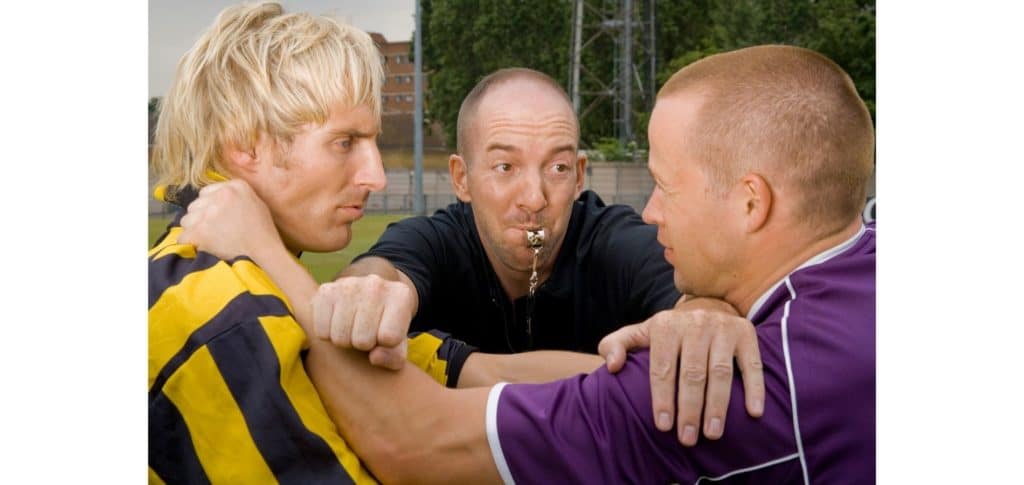Football is a game of many rules.
Players are expected to maintain good conduct on the field of play, as well as exercise x of fairness and sportsmanship.
Although in some scenarios, referees who control the flow of the game are left with no choice but to punish a team for committing a foul that contradicts the rules of the sport.
This is particularly evident in the case of penalties.
Penalty kicks are awarded in the event of a player touching and gaining control of the football via their hands or part of their arms; through reckless and careless behaviour; committing to challenges with excessive amounts of force and through general acts of indiscipline, all within the penalty area.
The list of possible offences doesn’t even end there!
But I’ll get back to that in a moment.
For now, I’m going to give a bit more insight into what a penalty is.
What is a penalty kick?
According to Law 14 of the International Football Association Board Laws of the Game, a penalty kick is a scoring opportunity given to a team adjudged to have been on the receiving end of a direct free kick offence inside the opposition’s penalty area or off the field as part of play.
Sounds a bit confusing, right?
Well, to make things clearer I suggest you take a look at the video below, which illustrates exactly what penalty kicks look like.
As you can see from the short clip, a goal can be scored directly from the penalty spot without interference from any outfield opposition.
Committable offences that may lead to the awarding of penalty kicks
With that definition out of the way, I can now revert to talking about the types of offences that pave the way for penalties to take place within the game.
So, let’s get started.
1. Handballs

The name “football” tells you all you need to know about this one.
Because this is a sport that is primarily played with the feet, any scenario (goalkeepers excluded) where a player deliberately touches the ball with their hand or a part of their arm is regarded as an illegal offence.
Subsequently, a direct free kick or an indirect one, is given to the team that suffered the disadvantage from the handball offence.
Most importantly however, is that referees signal for penalty kicks in situations where the perpetrators illegally handled the ball within their own penalty area.
2. Recklessness, carelessness or use of excessive force
It’s safe to say that football is a sport that does not tolerate the deliberate or accidental infliction of injuries among its participants.
Therefore, players who “cross the line” by way of making tackles, charges, pushes and challenges that are excessively forceful, careless or reckless in nature will be penalised accordingly.
Spot kicks are even given if a player holds, impedes or even head-butts an opponent within their own penalty area, so it’s important for teams to avoid having these moments of rashness as they can impact a football score line significantly.
3. Behavioural indiscipline

In a few instances, penalties are awarded when a player carries out any of the following actions within their own 18-yard box:
- bites or spits on an opponent
- punches or kicks a team mate, substitute, opponent or match official
- throwing an object at the football, an opponent or match official
- interfering with the flow of the game after re-entering the field of play without the express permission of the referee
Here’s a useful table which categorises all these offences for ease of future reference:
| Offence Category | Offence Name |
|---|---|
| Handling offences | Handball (excluding the goalkeeper) |
| Carelessness, recklessness and excessive force | Charging at an opponent |
| Carelessness, recklessness and excessive force | Jumping onto an opponent |
| Carelessness, recklessness and excessive force | Kicking or attempting to kick an opponent |
| Carelessness, recklessness and excessive force | Pushing an opponent |
| Carelessness, recklessness and excessive force | Striking or attempting to strike an opponent |
| Carelessness, recklessness and excessive force | Tackles or challenges against an opponent |
| Carelessness, recklessness and excessive force | Tripping or attempting to trip an opponent |
| Foul play | Holding an opponent |
| Foul play | Impeding an opponent with contact (i.e. obstructing them) |
| Behavioural indiscipline | Biting or spitting at a player or match official |
| Behavioural indiscipline | Throwing an object at the football, an opponent or a match official |
| Behavioural indiscipline | Any physical offence against an active player, substitute or match official |
| Unauthorised re-entry onto the playing field | Interfering with the flow of the game |
| Disrupting play | A player temporarily off the field throwing an object onto it that interferes with the game, an opponent or a match official |
Where are penalty kicks taken from?
There is a circular spot – indicated with a white paint marking within the 18-yard box – that is where all penalties are taken from.
And this position is always at a distance of 12 yards (10.97 metres) from the goal line where the ball is supposed to be directed towards.
Final thoughts
So that concludes this article on why penalties are given in football.
Just as a simple reminder…
Various situations can lead to penalty kicks being awarded in a football match, from a player being found guilty of handling the ball within their penalty area; to holding or impeding an opponent in the box; charging or tackling recklessly and even pushing someone with excessive force.
If you enjoy the content that I create and would like to buy me a coffee, then I’d really appreciate it!
Any money that I earn through this donation will be re-invested into more content for this website.
Additionally, by sending in a donation you’ll also receive a copy of my recently released 190+ page eBook on Soccer Ball Care, as well as be subscribed to our mailing list where you’ll be regularly informed on the latest developments concerning the Soccer Whizz blog.
- Future Icons: Europe’s Emerging Midfield Maestros Set for Glory - December 4, 2023
- Kickstarting a Revolution: How Soccer Transformed the United States Over the Last Four Years - October 7, 2023
- 4-1-4-1 Soccer Formation [Analysis] - September 23, 2023

